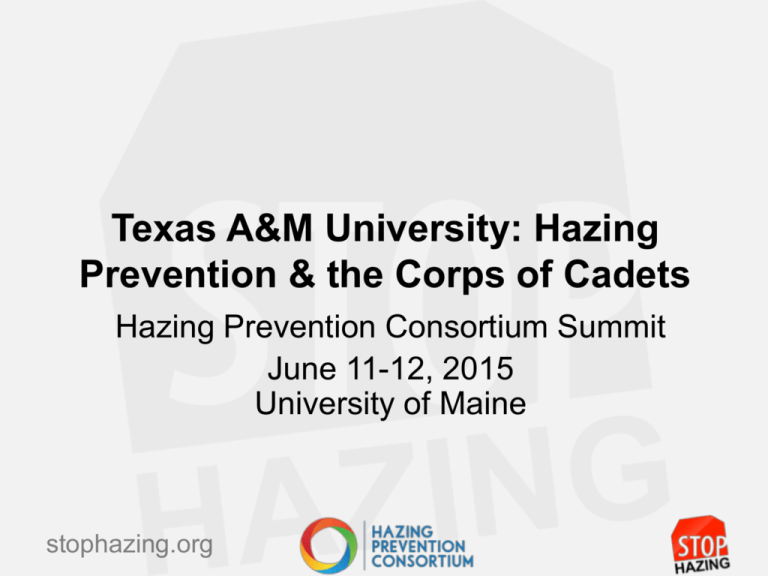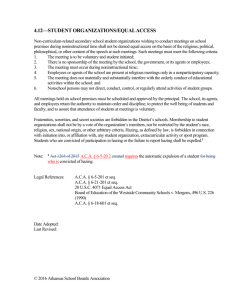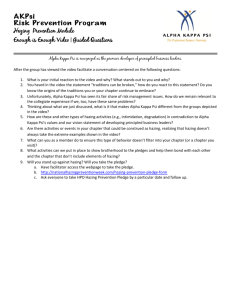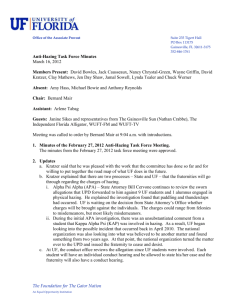Texas A&M University: Hazing Prevention & the Corps
advertisement

Texas A&M University: Hazing Prevention & the Corps of Cadets Hazing Prevention Consortium Summit June 11-12, 2015 University of Maine stophazing.org Campus Hazing Assessment Findings Campus Climate on Hazing Activity • 2000 – Student Conduct Office student survey • 2002 – Student Conduct Office surveyed staff on hazing • 2007 – participated in national study, Examining and Transforming Campus Hazing Cultures • Fall 2011 – worked with Drs. E. Allan and M. Madden; campus observations, individual interviews, focus groups w/students • January 2012 – student survey launched stophazing.org Campus Hazing Assessment Findings January 2012 Survey Results Group Affiliation: • Faith-based organization • Academic • Social fraternity/sorority (*93% affiliated with national) • Corps of Cadets stophazing.org Campus Hazing Assessment Findings Who Students Talked with about Hazing 92% 91% 74% 49% Another member Friend Family member Boyfriend/girlfriend stophazing.org Campus Hazing Assessment Findings Most frequently reported hazing behaviors 10% 6% 4% 4% 4% 4% Perform tasks only required of new members Be yelled, screamed, or cursed at by other members Deprive yourself of sleep Be awakened at night by other members Attend a skit night/roast where others are humiliated Associate with specific people and not others stophazing.org Campus Hazing Assessment Findings Location of hazing activities 34% 20% 19% 19% 9% Off campus in a private residence On campus in public building Off campus in public space On campus in dorm /private living area On campus in public outdoor space stophazing.org Campus Hazing Assessment Findings Perceived outcomes of participating in hazing behaviors 91% 81% 63% 28% 12% 2% feel more like part of the team/group feel a sense of accomplishment feel stronger feel stressed looking forward to your chance to do it to others feel humiliated or degraded stophazing.org Campus Hazing Assessment Findings Reflections regarding the initiation or tradition 85% 81% 25% 24% thought it was a good bonding activity thought it was fun at the time felt nervous or scared thought it was stupid stophazing.org Campus Hazing Assessment Findings Recognition & Labeling of Hazing Experiences “While 26% of TAMU student respondents who affiliate with a student organization or team report experiencing at least one hazing behavior as a part of joining or maintaining membership in their group, only 2% say they were hazed when given the definition and asked directly if they were hazed.” stophazing.org Campus Hazing Assessment Findings Reasons for not reporting hazing activities 50% I didn’t know where to report. 50% Didn’t want to be an outsiders if others found out I reported. 50% It was not a big deal. 50% No one got hurt. 50% It was tradition. 50% I chose to participate. stophazing.org Campus Hazing Assessment Findings Campus Culture – Themes • • • • Involvement & Leadership Shared Values & Traditions Community/Family Prestige & Pride The themes are distinct but intersect to produce a strong “Aggie” identity that characterizes student experience at TAMU. stophazing.org Campus Hazing Assessment Findings stophazing.org Hazing Prevention Core Strategies Coalition Building • • • • • • • Corps of Cadets/Band Student Activities Greek Life Athletics Academics University Police Department Association of Former Students stophazing.org Hazing Prevention Core Strategies Training • • • • Student Organization Advisors Chapter Advisors Athletics – coaches and student-athletes Student Leaders • Yell Leaders, IFC • Residence Life Staff • Resident Advisors, Hall Directors, Community Directors stophazing.org Hazing Prevention Core Strategies Visible Leadership Strategy • Face-to-face presentations • • • • Corps of Cadets Greeks Athletes Yell Leaders • Partnering with other Administrators • • • • Commandant of the Corps of Cadets Executive Associate VP for Student Affairs Head Football Coach Director of Student Activities stophazing.org Hazing Prevention Core Strategies Communication to Broader Campus Community • • • • Parent & Student Sessions – new student orientation Parent List serve Greek Alumni Stophazing.tamu.edu stophazing.org Hazing Prevention Core Strategies Bystander Intervention Corps of Cadets • Watch out for “buddies” in outfit • Corps Values stophazing.org Evaluation Case Study Activity Texas A&M Corps of Cadets stophazing.org Evaluation Case Study Activities Hazing Dr. David W. Parrott Executive Associate Vice President for Student Affairs Dr. Anne Reber Dean of Student Life Texas A&M University stophazing.org Evaluation Case Study Activities Texas A&M’s Core Values • • • • • • Excellence Integrity Leadership Loyalty Respect Selfless Service stophazing.org Evaluation Case Study Activities TAMU Core Values Corps Core Values - Excellence - Integrity - Leadership - Loyalty - Respect - Selfless Service - Excellence - Integrity - Honor - Discipline - Courage - Selfless Service stophazing.org Evaluation Case Study Activities Corps of Cadets Core Values • Honor – An unwavering commitment to sound moral values and strong character by respecting others as you fulfill your duties as a member of the Corps of Cadets. • Courage - The ability to face fear, danger, or adversity; both physical and moral courage. • Integrity - The honesty and moral courage to always defend and do what is right. • Discipline - Striving for excellence by holding yourself and others accountable to a higher standard. • Selfless Service - The desire and ability to put others before self, making personal sacrifices to better our Corps, university, state, and nation. stophazing.org 2014-2015 Corps of Cadets Organization Corps Staff CPT CPT Whitaker Brummett 1ST Brigade 2ND Brigade A-2 B-1 F-2 L-1 E-1 I-1 K-1 GySgt Regan MGySgt Hauffe GySgt Parker LtCol Felts 3RD 1ST 2ND 3RD Brigade Regiment Regiment Regiment V-1 D-Co Vacant LtCol Norris LCDR Hassman SGM Moser 1ST Wing 2ND Wing 3RD Wing Aggie Band A-1 C-2 E-2 K-2 SQ-3 SQ-1 SQ-2 B-2 G-2 F-1 N-1 SQ-8 SQ-12 SQ-6 C-1 D-1 stophazing.org P-2 S-1 H-1 S-2 SQ-4 SQ-18 SQ-11 SQ-17 SQ-16 SQ-21 Infantry Band Artillery Band A-Co A-Batt B-Co B-Batt C-Co C-Batt SQ-20 SQ-23 23 Evaluation Case Study Findings & Evidence Base stophazing.org Evaluation Case Study Findings & Evidence Base Fish Class Size by School Year* 2007 – 2015 962 874 815 791 679 643 700 Four Year Average 703 2007 2008 2009 Four Year Average 898 2010 2011 Fish stophazing.org 938 2012 2013 2014 Evaluation Case Study Findings & Evidence Base Category 08-09 09-10 10-11 11-12 12-13 13-14 14-15 Alcohol 10(0) 16(3) 25(4) 29(12) 33(15) 13(8) 19(11) 29(9) 49(11) 70(23) 33(26) 29(24) 43(28) 23(21) Drugs 17(10) 8(1) 3(1) 13(2) 7(3) 13(8) 17(0) Hazing 35(17) 28(0) 47(14) 111(68) 26(16) 15(12) 6(6) 2(1) 0(0) 1(1) 7(2) 9(0) 3(1) 5(5) Conduct Unbecoming 49(30) 54(17) 32(7) 54(25) 56(21) 62(42) 57(43) Other 22(0) 13(0) 14(0) 0(0) 0(0) 0(0) 0(0) 150(99) 127(86) 2450 2470 (DWI/DUI/MIP/PI) Alcohol (Underage/ Contributing) SASH Total Corps Strength 165(67) 168(32) 192(50) 247(135) 160(79) 1888 stophazing.org 1909 2002 2177 2303 Hazing Prevention Lessons Learned • There are many who are interested in the work but competing interests keep others away • Cannot stop the work • Collaborate; network; build relationships • Everyone must be involved • Document, document, document • Don’t underestimate the impact of our work stophazing.org Hazing Prevention Consortium Think Tank 1. Is this incoming freshman class (whom some call Generation Z) different than the millennials of the past few classes? How will they impact our work? 2. How can I have conversations with students/student leaders so as to gather information but still provide awareness of the issue? (Inquiry Model?) 3. How do I compete with other major issues impacting our campus (e.g., Title IX, academics vs. student affairs)? stophazing.org




